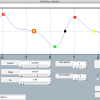The generation of discrete movement with distinct and stable time courses characterizes each human movement and reflect the need to perform catching and interception tasks and for timed action sequences, incorporating dynamically changing environmental constraints.  Several lines of evidence suggest neuronal mechanism for the initiation of movements i.e. in the supplementary motor area (SMA) and the premotor cortex and for movement planning mechanism generating velocity profiles satisfying time constraints.
Several lines of evidence suggest neuronal mechanism for the initiation of movements i.e. in the supplementary motor area (SMA) and the premotor cortex and for movement planning mechanism generating velocity profiles satisfying time constraints.
In order to meet the requirements of on-line evolving trajectories we propose a model, based on dynamical systems which describes goal directed trajectories in humans and generates trajectories for redundant anthropomorphic robotic arms. The analysis of the attractor dynamics based on the qualitative comparison with measurements of resulting trajectories taken from arm movement experiments with humans created a framework able to reproduce and to generate naturalistic human like arm trajectories.
State-of-the-art microelectrode array technology enables simultaneous, large-scale single unit recordings from hundreds of channels. Identification of channels recording neural data as compared to noise is the first step for all further analyses. Automatizing this process aims at minimizing the human involvement and time for manual curation. In our previous study, we introduced the “SpikeDeeptector” (SD), … Read More “SfN: Universal Spikedeeptector” »


